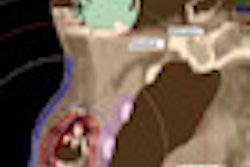The American Society for Radiation Oncology (ASTRO) this week published a new set of clinical guidelines covering the use of accelerated partial-breast irradiation (APBI) as a treatment for early-stage breast cancer.
APBI is a shortened course of high-dose radiation therapy that is delivered directly to the lumpectomy cavity, typically over a five- to seven-day period of time. It is still considered investigational, because it is not known yet if the treatment is as effective as whole-breast irradiation, in which the breast is treated with low doses of radiation administered five days a week for a six- to seven-week treatment period.
APBI is increasingly being utilized in lieu of whole-breast radiation following breast conservation surgery. Use of APBI outside of clinical trials for carefully selected patients is rapidly increasing in the U.S. and Europe, due to the technique's decreased radiation dose to the breast and chest wall, rapid treatment time, and higher percentage of treatment completion by patients.
But long-term clinical results on APBI's effectiveness compared to conventional whole-breast radiation may not be available for at least a decade, and many oncologists and their patients don't want to wait that long. Based on outcomes from short-term clinical trials, many patients are willing to take the risk.
Acknowledging this fact, in June 2008, ASTRO of Fairfax, VA, assembled a task force of experts in breast cancer surgery, radiation oncology, and physics to develop a consensus statement on when to use APBI. The 14-member group was headed by Major Benjamin D. Smith, M.D., chief of the radiation oncology department of Wilford Hall Medical Center at Lackland Air Force Base in San Antonio.
The consensus statement is designed to provide guidelines for use outside clinical trials, and to serve as a framework to promote additional clinical investigations. It was published in the July 15 issue of the International Journal of Radiation Oncology, Biology, Physics (2009, Vol. 74:4, pp. 987-1001).
Patient eligibility
The task force created four categories to describe eligibility for APBI: suitable, cautionary, unsuitable, and unacceptable. APBI is considered unacceptable for women who are pregnant, have had prior radiation therapy treatment, or have a history of collagen vascular disease.
The other three categories of eligibility -- suitable, cautionary, and unsuitable -- cover women with a very low risk of clinically occult disease remote from the lumpectomy cavity. Selection criteria for the suitable group are based on characteristics of patients enrolled in prospective single-arm clinical studies who had a minimum of four years of follow-up. Members of the task force were comfortable identifying women as suitable for APBI based on the criteria for participants in the majority of clinical trials whose results have been positively reported.
All other inclusion criteria being equal, age is a key factor in differentiating between suitable, cautionary, and unsuitable patients for APBI, with the technique considered to be of greater unknown risk to the younger patient. The task force based its decision on an insufficient number of clinical trials for younger age groups and the small size of patients enrolled in these trials. The task force also noted that patients older than 60 years of age experienced a lower risk of breast cancer recurrence with both APBI and whole-breast irradiation.
Other suitability requirements are listed below. If a patient has any factor in the cautionary list, the task force recommended that oncology care providers "invoke caution and concern." Similarly, if any patient has any characteristic listed in the unsuitable column, she should receive APBI only in the context of a clinical trial.
ASTRO consensus statement on APBI suitability factors
|
Informed consent, diagnostic tests, and timing
Oncologists are advised to tell patients that the long-term effectiveness and safety of APBI treatment are not fully known, and they may have a higher risk of ipsilateral breast tumor recurrence. Patients should be informed of the increased risk of toxicity with APBI, including local fibrosis, fat necrosis, and poor cosmesis. Informed-consent statements must be signed prior to breast conservation surgery.
All patients should be encouraged to participate in available clinical trials, particularly the Radiation Therapy Oncology Group (RTOG) 0413 National Surgical Adjuvant Breast and Bowel Project B-39 randomized trial. Oncologists are requested to discuss clinical trial results appropriate to the patient's own conditions and type of APBI treatment being recommended.
The task force also recommended that diagnostic mammography examinations and breast ultrasonography be performed prior to lumpectomy surgery.
The task force, however, did not specifically recommend breast MRI imaging for presurgical planning, because it stated that there are no data to suggest that incorporating breast MRI exams for patients treated with APBI results in a lower risk of cancer recurrence. It noted that clinicians may order breast MRI exams on a routine basis, and stated that future published data may change this opinion.
In addition, adjuvant chemotherapy should not be initiated for two to three weeks for patients who require APBI to reduce the risk of skin reactions and suboptimal cosmesis, according to the group.
Evaluation and preference of techniques
The types of APBI treatment available include single-entry balloon catheter, multifield external-beam therapy, interstitial brachytherapy, and intraoperative electron-beam therapy, both proton therapy and 3D conformal radiotherapy/intensity-modulated radiation therapy. The task force did not identify an optimal technique, nor did it express a preference for the APBI treatment utilized, instead discussing the pros and cons of each.
By Cynthia E. Keen
AuntMinnie.com staff writer
July 16, 2009
Related Reading
Study: Partial-breast irradiation is cost-effective, June 3, 2009
Effectiveness of APBI breast cancer treatment is age-neutral, study suggests, April 20, 2009
Single-entry APBI offers flexibility in treating breast cancer, April 3, 2009
Study: APBI compares favorably to standard RT, October 1, 2008
Copyright © 2009 AuntMinnie.com



















